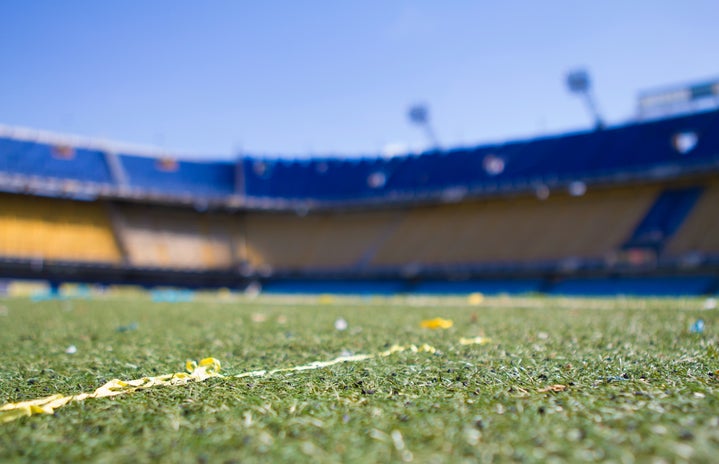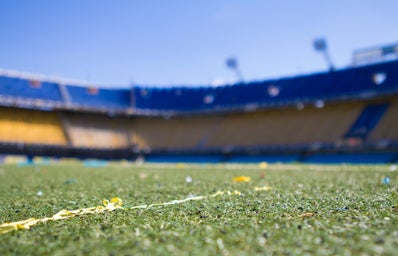On September 16th, following the hot-mic gaffe of the University of Nebraska’s President, the Big Ten Conference announced its decision to kick off the previously-cancelled football season, which will begin in late October. Fans and students alike may be excited to see a return to normalcy in the form of an autumn pastime back on their TVs. But health experts and residents of college towns worry that the negative ramifications of reinstating the season will far outweigh the positives of putting athletes back on the field.
Concern over the conference’s green light for football is running especially high in Michigan. The announcement comes on the heels of unrest in Ann Arbor and East Lansing regarding COVID-19 precautions and the University of Michigan’s Graduate Employee Organization going on strike. In a vote of no confidence by the University Faculty Senate on the same day as the Big Ten press release, U of M President Mark Schlissel’s performance in response to reopening from COVID-19 closures was contested by various voting procedures. The staff have stated that the Senate is seeking legal advice on how to proceed. It’s been a restless start to the school year at UM, as graduate faculty went on strike two weeks ago, citing inadequate COVID-19 protections for staff in the haste to bring students back to campus. In East Lansing, COVID-19 cases have spiked, despite the vast majority of students not living anywhere near Ingham County. As of September 12th, there were 342 cases of the virus in people affiliated with Michigan State, many of which were found to be a result of students living off campus throwing house parties and other social events not condoned or permitted by the college itself. MSU students were asked to quarantine for fourteen days following the spike, with Ingham County health officials expressing concern over students potentially causing a breakout among year-round citizens of the area. In light of all these pressing issues, it seems callous and careless of the Big Ten to be prioritizing the return of the football season over tackling the problems large college campuses are currently facing.
The role and treatment of student athletes, particularly ones in high-profile sports such as football and basketball, has been a hotly debated subject over the past few years. Americans regularly puzzle over whether or not college athletes should be paid for their participation, whether they should be allowed to profit off of the sale and sponsorship of their names and images, and whether or not admissions processes go too easy on athletes at academically elite schools. In the age of coronavirus, a host of new questions has arisen: should athletes be treated as guinea pigs for entire student bodies living on college campuses? Is it ethical for student athletes to be playing at all, even with COVID-19 restrictions in place, as college football can’t exist in a bubble like the NBA or other professional sports? Are colleges paying too much attention to the financial vacuum of NCAA sports instead of working to safely and effectively educate students from home, with the goal of eventually resuming face-to-face learning? How will the return of college sports potentially inhibit that return to campuses and regular education? These are loaded questions, but they’re the ones we should all be asking ourselves before we lend our viewership to the Big Ten this fall and winter.
It’s estimated that at Michigan State, the football program brings in upwards of eighty million dollars a year, accounting for 57% of athletic revenue the university counts. At the University of Michigan, it’s a whopping 122.3 million dollars, making the program both the richest in the Big Ten and the third most valuable football program in the country. It’s the worst-kept secret in the Midwest that these two flagship Big Ten universities were under tremendous financial pressure to reinstate football for the 2020 season – losing that kind of money when thousands of students have opted to go online or defer their admission and cancelling millions of dollars in housing contracts and tuition fees is a steep price to pay. Colleges in the South that have resumed football seasons as scheduled have seen spikes in cases both on and off of teams – after all, who really expects students in vehemently football-crazy college towns to keep it under ten people at a distance of six feet when celebrating the return of this tiny grab at normalcy? Big Ten chancellors made it clear where their priorities lie in the new referendum on public health: football and money. Discreet house parties and clandestine tailgates be damned, the payout wins the day once again in the highly monetized system of American college.
The other predominant factor of widespread trepidation surrounding the football season is the prioritization of rapid coronavirus testing for athletes. Universities have committed to testing their football players once a day, and any team with higher than five percent of players testing positive will lose eligibility to play. These new regulations have left many students wondering why, if rapid testing can be procured for athletes, could it not be organized to safely bring them back to campuses? Prior to Michigan State’s announcement that students wouldn’t be returning to campus in August, there was no plan for testing students to bring them to East Lansing. The students that were allowed to return were limited to only being tested on-campus if they were showing symptoms of COVID-19. The testing of athletes begs the question of a larger moral dilemma that’s been raised recently, as celebrities tout quick testing on social media: why is it that the rich, famous, and powerfully aligned can get easy and quick access to COVID-19 testing when millions of working-class Americans have to struggle to access and must wait weeks to get results from the same testing services?
It can be said that the Big Ten is a corporation with every right to conduct business to whatever extent deemed possible by medical professionals during this time. It can be said that college football programs at large universities help pay for scholarships and the upward mobility of many students. It can even be said that we don’t need to ask the big questions of morality and ethics, because the system will exist as it is regardless. But it must also be said that while the Big Ten is a corporation, it is enabled and regulated by public universities which receive money from taxpayers via state government grants, as well as the finances of tens of thousands of students who don’t benefit from the revenue generated by football. The vast majority of students at Michigan State or UM will not be impacted, monetarily or otherwise, by the decision to renew the football season. Likewise, employees of the universities and of the Big Ten itself aren’t likely to lose their livelihoods if the season were to be postponed to the spring. The lowest-paid employees in the Big Ten are predominantly minimum-wage network interns or freelance contractors, with the majority of positions being well-secured, upper-five figure salaries that include hefty benefits. One could say that college towns depend on the business revenue generated by a football season. But that income is largely dependent on the presence of fans packing stadiums every weekend and then spilling out into bars afterwards, two things that won’t be happening this year, regardless of whether or not football happens. The Big Ten is legally bound by the COVID-19 regulations of the states in which it plays to keep its crowds under a certain number of people – in Michigan, Governor Whitmer’s current regulation for sporting events is one hundred people. Similarly, most, if not all, bars and restaurants are either closed for dining-in or are operating at extremely limited capacity, and a football season won’t necessarily provide an economic boost for these cities. No audiences also means no smaller-scale food or souvenir vendors. The argument that bringing back Big Ten football this fall will provide communities with a financial bolstering just doesn’t seem to apply here.
The most ardently invoked point by advocates for resuming the football season is that we as a country have to begin returning to normalcy at some point, and that the risk has been significantly lowered in the months since the beginning of the pandemic. However, there are no medical professionals out there claiming that bringing back football will pose no risk to colleges and communities. In fact, the NCAA recognized that by prohibiting universities from requiring athletes to sign COVID-19 risk waivers in order to play. Beyond that, cases of COVID-19 have been linked to myocarditis, an inflammation of heart muscle, a condition which is potentially fatal and has been found in roughly thirty-five percent of Big Ten athletes who tested positive for the coronavirus. The presence of this separate risk leaves universities and conferences vulnerable to negligence lawsuits if athletes or their families were to become infected and sustain long-lasting injuries or fatalities. Some legal experts have questioned whether or not these types of claims would hold up in court. Any student athlete that is concerned about the health implications of playing a season during the pandemic is allowed to opt out and retain their scholarship. The other shoe, that will drop imminently, is that there are many other pressures keeping athletes on the field besides scholarship money, and those external factors will likely force athletes to play even if they’re concerned about their health. The duress of a positive relationship with coaches and teammates, as well as the possibility of a falling out with staff that controls playing time and future scholarship eligibility, is enough to make any athlete stay in the game against the better judgement of health reasoning.
The most blunt conclusion to draw from the decision to resume the Big Ten football season is that the both colleges and the corporation have a warped sense of risk reduction. Perhaps the precautions will be enough to reduce the risk of COVID-19 spikes to an extent, but the most effective way to run the greatest risk reduction possible would be to simply postpone the season as planned.


